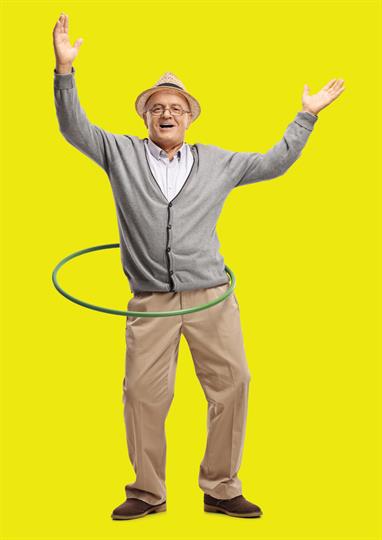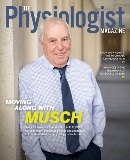Fountain of Youth?
New research helps us understand how exercise affects aging.
By Dara Chadwick
 Browse the magazine rack at your local supermarket and you’ll likely see headlines like “Sexy Abs in 7 Days” and “Ripped Right Now.” It seems the lay media would have readers believe that visibly changing your body is as
simple as hitting the gym a few times.
Browse the magazine rack at your local supermarket and you’ll likely see headlines like “Sexy Abs in 7 Days” and “Ripped Right Now.” It seems the lay media would have readers believe that visibly changing your body is as
simple as hitting the gym a few times.
It’s enough to make an exercise physiologist laugh out loud.
In this new year, as droves head to the gym determined to meet their fitness goals, physiologists who study exercise remain focused on what we know—and sometimes more importantly, what we don’t know—about exercise’s effects on the body. While people often say they want to “get in shape,” beneath this generality is a series of complex physiological processes.
“We know from research that during exercise, hormones and chemicals are made in the muscles, liver, brain, etc.,” says Scott Trappe, PhD, director of the Human Performance Lab at Ball State University in Muncie, Ind. “It’s all connected at some level. We’re learning more about it.”
Trappe and his brother, Todd Trappe, PhD, professor of exercise science in the Human Performance Lab, have focused on exercise’s impact on aging for more than two decades. Their study “Cardiovascular and Skeletal Muscle Health with Lifelong Exercise,” which was published in the Nov. 1, 2018, issue of the Journal of Applied Physiology, compared the maximum oxygen consumption (VO2 max) and skeletal muscle metabolic fitness of women and men in their 70s who were lifelong exercisers with healthy non-exercisers in their 70s and with exercisers in their 20s. Additionally, male lifelong exercisers were separated into two groups: those who trained moderately for fitness and a “performance” group who trained more vigorously for competitive events.
Over the course of six weeks, study participants were evaluated on body composition using fasting blood draws, resting and exercise electrocardiograms, MRI to measure muscle mass, and resting and strategically timed post-exercise muscle biopsies, among other measures. “What we saw was that the benefits of exercise were outstanding,” says Scott Trappe.
Among the performance group, researchers saw participants whose cardiovascular systems looked 30 years younger than their age, while among the fitness group, they saw participants whose cardiovascular systems looked 15 to 20 years younger. Aerobic quality of the muscle was the same in both groups, he says.
“We know that muscle mass loss is a big problem in aging and that we do have a decline in physiologic function as we age,” Scott Trappe says. “But we know that exercise slows the decay.”
A Whole-body Approach
If you’re planning to use exercise to induce a change in your body—such as losing weight, improving cardiovascular health, boosting metabolism, controlling glucose levels, or maintaining mobility and muscle mass as you age—you need to know that not all exercise is the same.
“Exercise has an effect on not only active muscles, but almost every tissue in the body, such as brain, heart, liver, kidney, etc. But one type of exercise doesn’t fit all needs,” says Sue Bodine, PhD, professor of medicine at the University of Iowa Carver College of Medicine in Iowa City and editor-in-chief of the Journal of Applied Physiology. Her research has focused primarily on understanding the mechanisms that regulate skeletal muscle mass, using animal models to study how hypertrophy increases muscle mass and how inactivity and disuse produce muscle atrophy.
Resistance exercise—where you’re working against an external load—causes hypertrophy, which increases muscle strength, she says. “In a 12-week program, muscle strength progressively increases due to neural adaptation and increases in muscle size,” Bodine says. “Significant hypertrophy caused by an increase in muscle fiber size results in increases in strength.”
Resistance training is highly effective for people of any age, including those in their 70s, 80s and even 90s, according to Todd Trappe. “When you increase the amount of muscle you have, it helps with other metabolic processes,” he says. “We promote a ‘bread-and-butter’ approach.” He says they’ve seen huge gains in people doing resistance exercises for three sets of 10 repetitions per muscle group three days a week. This approach—in which an individual lifts an amount of weight that fatigues their muscle at about 10 repetitions (meaning they can’t lift another repetition)—would be useful for most muscle groups in the body, Trappe adds.
Maintaining muscle mass is important as we age, says Melissa Markofski, PhD, assistant professor in the Department of Health and Human Performance at the University of Houston in Texas, who studies both the role of skeletal muscle and the immune system in healthy aging. “If we maintain muscle mass, we’re more likely to maintain muscle function,” she says, adding that regular exercise also helps prevent systemic low-grade inflammation. “When a monocyte infiltrates muscle tissue, it transforms into a macrophage. The macrophage then produces inflammatory cytokines. While we don’t want macrophages to leave muscle tissue completely because they do have a ‘good’ role, exercise seems to keep the macrophages on these ‘good’ tasks and not the pro-inflammatory role. People who exercise have a lower percentage of cells with pro-inflammatory signals.”
How Much Is Enough?
Those who indulged a bit over the holidays may be wondering if exercise is the key to a quick recovery. Yes … and no. “There’s a saying that you can’t outrun a bad diet,” Markofski says. “But exercise helps us maintain healthy blood glucose and maintain weight.”
Losing weight requires a heavier exercise effort—about 300 minutes a week compared to the weekly 150 minutes of moderate exercise or 75 minutes of vigorous exercise (plus resistance training twice a week) in standard guidelines, she says, adding that dietary changes may be needed to see results.
Endurance (aerobic) exercise improves metabolic factors, Markofski says. “Evidence supports that aerobic exercise increases HDL cholesterol, helps keep fat mass low, helps control blood pressure and improves glucose control,” she says.
Aerobic exercise also boosts stamina, increasing mitochondria content and the ability to metabolize fat, Bodine says. It can be especially beneficial for people with chronic conditions such as diabetes. “When a person does aerobic exercise, muscle contraction increases glucose uptake,” she says. “This is especially helpful for someone with diabetes where insulin-regulated glucose uptake is impaired.”
Building or preserving muscle is also important for maintaining basal metabolism, according to Bodine.
So if you’re exercising, when can you expect to see results? Generally, Markofski says, with moderate to vigorous exercise, cardiorespiratory fitness improvements are measurable at four to six weeks, while fitness improvements are seen at four to eight weeks. The bad news? Stop exercising and you’ll see your gains disappear fairly quickly.
A New Era in Exercise Research
While the general benefits of exercise are widely known among physiologists, many questions remain as to how exercise affects people at an individual level. “With exercise, there’s a lot of interesting biology going on under the hood,” Scott Trappe says. “When you start to peel back the layers, we don’t know the molecules underneath.”
Both Trappes and Bodine are participating in the Molecular Transducers of Physical Activity Consortium (MoTrPAC), a national research consortium “designed to discover and perform preliminary characterization of the range of molecular transducers (the molecular map) that underlie the effects of physical activity in humans.” The six-year effort, supported by the National Institutes of Health Common Fund, has nearly completed its planned animal studies, and clinical sites are now recruiting for the adult study.
With 2,000 participants being recruited, MoTrPAC is one of the largest human exercise studies and will expand what we know about how exercise impacts the body, Bodine says. “The initial goal is discovery. It’s a big data project looking at what molecular pathways are activated in response to exercise,” she says. “People respond differently to exercise. One end goal is to be able to prescribe exercise and to have a scientific basis for it.”
Scott Trappe says the MoTrPAC project marks a new era in exercise research. “We don’t yet have a handle on heterogeneity in exercise,” he says. “There’s an argument in the lay media that some people don’t respond to exercise. MoTrPAC will allow us to look at genetic variations in a larger population.”
Todd Trappe says the inclusion of “omics” experts in the study will make MoTrPAC different. “We are expecting to collect petabytes of data on the participants, and the expertise across the consortium will be necessary to stitch this magnitude of information together into a meaningful story,” he says.
But while understanding the molecular map of how exercise affects the body may yield critical data to inform exercise recommendations for individuals, it may not tell researchers something critical: how to get people to stick to an exercise program.
“It could be partially genetic,” Bodine says of why people don’t exercise. “But we also need to be thinking about exercise when designing communities. Our daily amount of activity has been decreasing because of technology.”
Still, even those who are well aware of exercise’s benefits may have trouble getting to the gym. “That’s when you call a psychologist, not a physiologist,” Todd Trappe says.
Save the date › November 11–13, 2020 › Austin, Texas
Integrative Physiology of Exercise Conference
Exercise physiologists: Plan to attend the Integrative Physiology of Exercise conference in Austin, Texas, this November. The conference—organized by Scott and Todd Trappe and other leading experts—is geared toward all scientists working in the field of exercise physiology and those interested in learning more about the field. The conference theme is “Distinguished Past, Bright Future.” We are excited to present a program that will include many opportunities for researchers to present their research, network and hear presentations on a variety of topics in exercise research. Visit www.physiology.org/ipe2020 for updates on the conference program, deadlines and awards.
Conference highlights will include:
- New science in areas not routinely covered at this conference such as exercise and organ cross-talk, connective tissue and exercise, astronaut health for a mission to Mars and performance-enhancing agents for health and athletic competition.
- Preclinical and clinical updates from the $200 million National Institutes of Health Molecular Transducers of Physical Activity Consortium initiative.
- Recognition of key historical milestones in exercise physiology, including the 100-year anniversary of August Krogh’s 1920 Nobel Prize for capillary diffusion, a century of progress since A.V. Hill’s seminal foundation of VO2max, and
the many scientific contributions of John Holloszy.
- A focus on trainees and early investigators with oral presentation opportunities, quiz bowl competition, a chaperone program, numerous awards and much more.
The Physiologist Magazine
Read the Latest Issue
Don’t miss out on the latest topics in science and research.
View the Issue Archive
Catch up on all the issues of The Physiologist Magazine.
Contact Us
For questions, comments or to share your story ideas, email us or call 301.634.7314.


